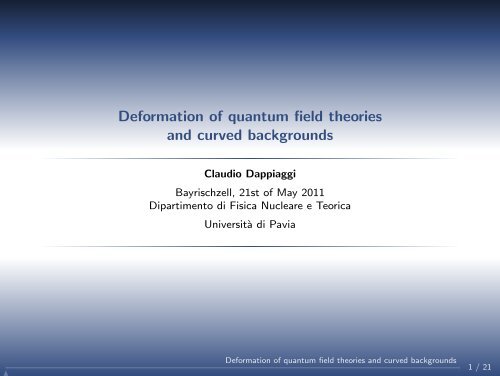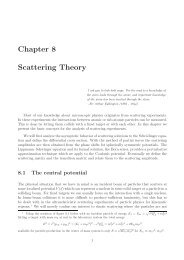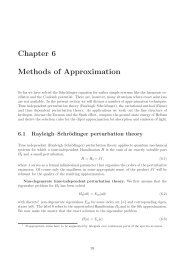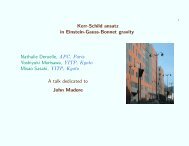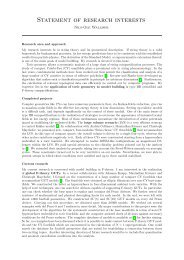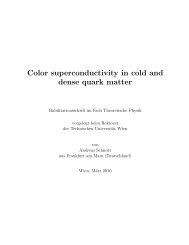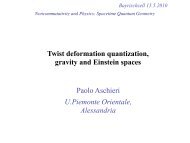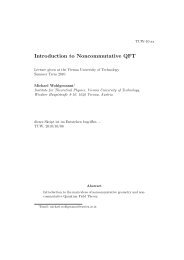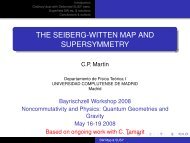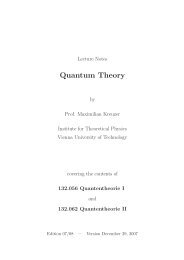You also want an ePaper? Increase the reach of your titles
YUMPU automatically turns print PDFs into web optimized ePapers that Google loves.
Deformation of quantum field theoriesand curved backgrounds<strong>Claudio</strong> <strong>Dappiaggi</strong>Bayrischzell, 21st of May 2011Dipartimento di Fisica Nucleare e TeoricaUniversità di PaviaDeformation of quantum field theories and curved backgrounds1 / 21
Outline of the TalkMotivationsWedge regions in curved backgroundsWarped convolutions and curved backgroundsBased onConclusionsC. D., Gandalf Lechner and Eric Morfa-Morales: Comm. Math. Phys.305 (2011), 99 – ArXiv:1006.3548 [math-ph].Deformation of quantum field theories and curved backgrounds2 / 21
MotivationsMotivations - Part IDeformations of QFT have been thoroughly studied:as giving rise to quantum field theories on non-commutative spacetimesas a tool to construct new (interacting) models on commutativespacetimesYet, a closer look unveils thatmost of these models have been built on the Euclidean or on Minkowskispaceoften a choice of a preferred coordinate system is employedsharp point-like localization is weakened to localization in wedge-shapedregionsDeformation of quantum field theories and curved backgrounds3 / 21
MotivationsMotivations - Part IIHence a few natural questionswhat is the interplay between deformations such as warped convolutionsand non-trivial geometries?does any notion of covariance and locality survive?To this avail,we want consider curved backgrounds where warped convolutions can beappliedwe look for a suitable notion of wedge-regions in this frameworkwe want to work out explicit examplesDeformation of quantum field theories and curved backgrounds4 / 21
Wedge regions in curved backgroundsWedges in MinkowskiIn Minkowski spacetime (R 4 , η), we call right wedge{}W R := (x 0, x 1, x 2, x 3) ∈ R 4 , | x 1 > |x 0| .Let us notice thatevery other wedge W can be constructed from W R acting with a suitablePoincaré-isometryEach (W , η| W ) is a glob.-hyp. spacetime embedded in (R 4 , η)W R possesses an edge defined as{E(W R ) := (0, 0, x 2, x 3) ∈ R 4} .and W R is bounded by two non-parallel characteristic 3D planes whoseintersection is E(W R )Deformation of quantum field theories and curved backgrounds5 / 21
Wedge regions in curved backgroundsMore on wedges in MinkowskiFurther properties include:Each wedge is the causal completion of the world line of a uniformlyaccelerated observer.Each wedge is the union of a family of double cones whose tips lie on twofixed lightrays.The Poincaré group acts transitively on the family of all possible wedges.The family of wedges in Minkowski is causally separating; for any twospacelike separated double cones O 1, O 2 ∈ R 4 , there exists a wedge Wsuch that O 1 ⊂ W ⊂ O ′ 2Deformation of quantum field theories and curved backgrounds6 / 21
Wedge regions in curved backgroundsThe role of the edgeFor a generalization to curved backgrounds we notice that()W R ∪ W L = R 4 \ J + (E(W R )) ∪ J − (E(W R )) ,where W L. ={(x0, x 1, x 2, x 3) ∈ R 4 , | − x 1 > |x 0| } is the left-wedge.Notice:the edge admits a covariant characterization as the plane spanned by theflow of two spacelike Killing fields of η,consequently also the above region has been covariantly characterized.Strategy: Can we transfer this characterization to curved backgrounds?Deformation of quantum field theories and curved backgrounds7 / 21
Wedge regions in curved backgroundsAdmissible spacetimesWe shall only consider manifolds (M, g) which1 are globally hyperbolic spacetimes2 admit two complete, commuting and smooth Killing fields ξ 1, ξ 2 (why?)3 M is diffeomorphic to R × I × E, I ⊆ R while E is the 2D submanifoldidentified by the flow of ξ 1 and ξ 2 - Frobenius’ theorem (why?)We call Ξ(M, g) the set of all ordered pairs ξ . = (ξ 1, ξ 2) with ξ 1, ξ 2 as above.Deformation of quantum field theories and curved backgrounds8 / 21
Wedge regions in curved backgroundsEdges in admissible spacetimesFollowing Minkowski spacetime:We call edge the submanifold of (M, g)E ξ,p. ={ϕ ξ,s (p) ∈ M : s = (s 1, s 2) ∈ R 2 , p ∈ M},where ξ ∈ Ξ(M, g) and ϕ ξ,s = ϕ ξ1 ,s 1◦ ϕ ξ2 ,s 2is the flow of the Killing pair.Deformation of quantum field theories and curved backgrounds9 / 21
Wedge regions in curved backgroundsProperties of the edgesSince (M, g) is globally hyperbolic, M is isometric to R × Σ and∃T : R × Σ → R such thatg = −βdT 2 + hβ ∈ C ∞ (R × Σ, (0, ∞)) and h ∈ Riem(Σ)Hence:• at each p ∈ M we can assign an oriented basis of T pM(∇T (p), ξ 1(p), ξ 2(p), n ξ,p ).Lemma:The causal complement E ξ,p ′ of an edge E ξ,p is the disjoint union of twoconnected components, which are the causal complements of each otherDeformation of quantum field theories and curved backgrounds10 / 21
Wedge regions in curved backgroundsThe reason for M ∼ R × I × EThe above lemma would not hold without the assumption on the topology ofM!Suppose (M, g) is such that M ≡ R × S 1 × R 2 , where R × S 1 is the Lorentzcylinder. Then an edge looks like:Deformation of quantum field theories and curved backgrounds11 / 21
Wedge regions in curved backgroundsWedges in curved backgroundsDefinition [Wedge]:A wedge is a subset of an admissible spacetime (M, g) which is a connectedcomponent of the causal complement of an edge. Hence, for given ξ ∈Ξ(M, g) and p ∈ M, we call W ξ,p the component of E ξ,p ′ which intersectsthe curve γ(t) = . exp p (tn ξ,p ), t > 0.Each wedge W = W ξ,pis causally complete, i.e. W ′′ = W , hence globally hyp.,has a casual complement W ′ = W ξ ′ ,p where ξ ′ = (ξ 2, ξ 1),is invariant under the Killing flow generating its edge.Deformation of quantum field theories and curved backgrounds12 / 21
Wedge regions in curved backgroundsFamilies of wedges and their propertiesLet us now introduce the family of all wedgesW . = {W ξ,p : ξ ∈ Ξ(M, g), p ∈ M} .The set Wis invariant under the action of the isometry group of (M, g) and undertaking causal complementsis such that two elements W ξ,p and W ˜ξ,˜p form an inclusion W ξ,p ⊂ W ˜ξ,˜pif and only if p ∈ W ˜ξ,˜pand ∃N ∈ GL(2, R) with det N > 0 such that˜ξ = Nξ.Are there spacetimes which are admissible?Deformation of quantum field theories and curved backgrounds13 / 21
Wedge regions in curved backgroundsExamples of admissible spacetimeThere are several interesting admissible spacetimes:every warped product of a globally hyperbolic manifold X ∼ R × I with a2D Riemannian manifold E endowed with two complete spacelikecommuting Killing fieldsKasner spacetimes, a.k.a. Bianchi I models, that is M ∼ J × R 3 withJ ⊆ R andds 2 = dt 2 − e 2f 1dx 2 − e 2f 2dy 2 − e 2f 3dz 2 .f i = f i (t)as a particular case the FRW spacetime with flat spatial sectionds 2 = dt 2 − a 2 (t)[dx 2 + dy 2 + dz 2 ] = a 2 (τ)[dτ 2 − dx 2 − dy 2 − dz 2 ].Deformation of quantum field theories and curved backgrounds14 / 21
Warped Convolutions and curved backgroundsBasic IngredientsWe consider a QFT in the framework of Haag-Kastler axioms:We take a C ∗ -algebra F. The elements are bounded functions ofquantum fields on (M, g)A local structure exists: To each wedge W , we associate theC ∗ -subalgebra F(W ) ⊂ F∃ a strongly-continuous action α of ISO(M, g) on F∃ a Bose/Fermi automorphism γ of F such that γ 2 = 1, [α, γ] = 0,We assume that F is concretely realized on a separable Hilbert space HH must carry a unitary rep. U of ISO(M, g) and V of γDeformation of quantum field theories and curved backgrounds15 / 21
τ Nξ,s (F(W ξ,p )) = F(W ξ,p ), N ∈ GL(2, R), s ∈ R 2 16 / 21Deformation of quantum field theories and curved backgroundsWarped Convolutions and curved backgroundsFirst consequencesThe triple of data ({F(W )} W ∈W , α, γ) has the structural properties of a QFTIsotony) F(W ) ⊂ F(˜W ) if W ⊂ ˜WCovariance) under action of ISO(M, g), that is α h (F(W )) = F(hW ) forall h ∈ ISO(M, g) and for all W ∈ WTwisted Locality) If we introduce the unitary operator Z . = 1 √2(1 − iV )[ZFZ ∗ , G] = 0, ∀F ∈ F(W ), G ∈ F(W ′ ), W ∈ W.Note that covariance implies that ∀ξ ∈ Ξ, F carries an R 2 -action τ ξNote that isotony impliesτ ξ,s. = αϕξ,s = adU ξ (s), s ∈ R 2
Warped Convolutions and curved backgroundsWarped ConvolutionsWe have all the ingredients to define a deformed net W → F(W ) λ .To cope with the non trivial geometry we call F ∈ F ξ-smooth ifis smooth in the norm-topology of F.R 2 ∋ s ↦→ τ ξ,s (F ) ∈ F,We call deformed operator (warped convolution) of a ξ-smooth F ∈ F∫. 1F ξ,λ =4π lim dsds ′ e −iss′ χ(ɛs, ɛs ′ )U 2 ξ (λQs)FU ξ (s ′ − λQs),ɛ→0λ ∈ R, while s, s ′ ∈ R 2χ ∈ C ∞ 0 (R 2 × R 2 ) and χ(0, 0) = 1Q is the standard antisymmetric 2 × 2 matrix.Deformation of quantum field theories and curved backgrounds17 / 21
Lemma:Warped Convolutions and curved backgroundsProperties of the warped convolutionIf ξ ∈ Ξ and if F , G ∈ F are ξ-smooth, then1 F ∗ ξ,λ = (F ∗ ) ξ,λ2 F ξ,λ G ξ,λ = (F × ξ,λ G) ξ,λ whereF × ξ,λ G = . 1 ∫4π lim dsds ′ e −iss′ χ(ɛs, ɛs ′ )τ 2 ξ,λQs (F )τ ξ,s ′(G).ɛ→03 If [τ ξ,s (F ), G] = 0 for all s ∈ R 2 , then [F ξ,λ , G ξ,−λ ] = 04 If a unitary Y ∈ B(H) commutes with U ξ (s), s ∈ R 2 , thenYF ξ,λ Y −1 = (YFY −1 ) ξ,λ and the latter is ξ-smooth.Note that the third property entails:[Zτ ξ,λ (F )Z ∗ , G] = 0 =⇒ [ZF ξ,λ Z ∗ , G ξ,−λ ] = 0.Deformation of quantum field theories and curved backgrounds18 / 21
Warped Convolutions and curved backgroundsThe deformed netLet us consider the following datathe net based on wedges W ↦→ F(W ),the equivalence classes [ξ] where ξ ∼ ξ ′ , ξ, ξ ′ ∈ Ξ iff ∃h ∈ ISO(M, g) andN ∈ GL(2, R) with ξ ′ = Nh ∗ξ.the decomposition of W as ⊔ [ξ] W [ξ]Fix a representative ξ for all [ξ] and for p ∈ MF(W ξ,p ) λ. = {Fξ,λ : F ∈ F(W ξ,p ), ξ-smooth} ‖·‖ ,F(W ξ ′ ,p) λ. ={Fξ ′ ,λ : F ∈ F(W ′ ξ,p), ξ ′ -smooth } ‖·‖ ,where ‖ · ‖ stands for norm closure in B(H).Deformation of quantum field theories and curved backgrounds19 / 21
Warped Convolutions and curved backgroundsProperties of the deformed netNote that the def. above are extended to arbitrary wedges viaF(hW ξ,p ) λ. = αh (F(W ξ,p ) λ ),where α h (F ξ,λ ) = α h (F ) h∗ξ,λ for all h ∈ ISO(M, g).Theorem:The map λ ↦→ F(W ) λ identifies a well-defined isotonous, twisted wedgelocal,ISO-covariant net of C ∗ -algebras on H, that is ∀W , ˜W ∈ W1 F(W ) λ ⊂ F(˜W ) λ if W ⊂ ˜W ,2 [ZF λ , Z ∗ , G λ ] = 0 for F λ ∈ F(W ) λ and G λ ∈ F(W ′ ) λ3 α h (F(W ) λ ) = F(hW ) λ for all h ∈ ISO(M, g)4 if λ = 0 then F(W ) 0 = F(W ).Deformation of quantum field theories and curved backgrounds20 / 21
ConclusionsOutlook and PerspectivesWe haveidentified a notion of wedges in a large class of curved spacetimesapplied warped convolution deformation to QFT on these spacetimesproven that the deformed net preserves basic covariance andwedge-localizationWe want toextend the construction to a larger class of manifoldsextend the framework to non-Abelian isometriesbetter understand the structure of the new modelsDeformation of quantum field theories and curved backgrounds21 / 21


